Conjuration Creations
It’s Conjuration Week, and that of course means that today’s magical goodies will be drawing their power from that particular school of magic. Need to be prepared for anything? Take a look at our handy backpack of readiness. Go biblical on your foes by unleashing a plague of pests on them with our jar of endless vermin. Or make transportation simple with the easy-to-use teleportation badge. You can find all this, and more, below.
Backpack of Readiness
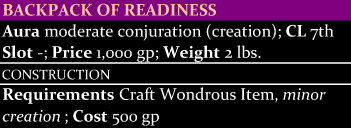
This plain-looking backpack is sturdy and well-built, but has clearly seen a lot of use. It functions in every way like a mundane backpack, except that, once per day, its owner can speak a special command word while opening the backpack (this command word is usually, but not always, stitched or engraved into the backpack somewhere on the inside). If he does so, he can also name a single mundane item no larger than Small size and worth no more than 25 gp. Once he does so, and opens the pack, he finds that it contains the named item (and only the named item). The next time he opens the pack, it contains whatever contents he had stored in it before he activated the backpack for the day.
Jar of Endless Vermin
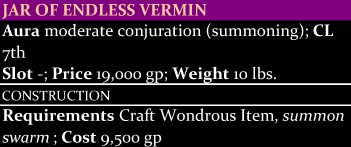
These jars are usually made of clay, and tend to be about two feet tall and about a foot in diameter. They are typically painted or engraved with images of spiders, scorpions, and other unpleasant creatures, and feature large stoppers with complicated and secure clasps. Three times per day, as a full round action, a jar of endless vermin can be opened, spewing forth a swarm of bats, rats, or spiders. This functions as the spell summon swarm, except that the swarm never attacks the person who opened the jar, and even if he shares a space with the swarm they do not damage him. He still does not control the swarm however, and cannot dictate who it attacks or doesn’t attack, much to the detriment of his allies. At the end of the effect’s duration, such swarms dissolve as their component members flee in different directions.
Alternatively, by using all three daily uses of the jar, it can instead be opened to release a swarm of centipedes, leeches, or wasps.
Finally, if the jar is ever destroyed, it immediately releases 1d6 swarms of bats, rats, or spiders and 1d4 swarms of centipedes, leeches, or wasps (determine the types of swarms individually and randomly, or at GM discretion). Unlike swarms summoned by opening the jar, these swarms persist until destroyed, and will attack any creature they encounter, including whoever destroyed the jar (they do not, however, attack the jar’s destroyer preferentially).
Pendant of Animal Aid
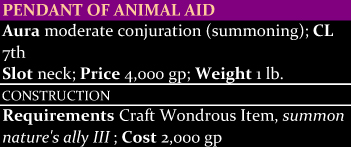
These talismans are prized by druids and others who make use of summon nature’s ally spells. Any time the wearer casts a summon nature’s ally spell, and chooses to summon a number of creatures from the next-lowest-level version of the spell, he may summon 1d4+1 of those creatures, instead of the normal 1d3. Additionally, if he chooses to summon a number of creatures from an even lower-level version of the spell, he summons 1d6 of those creatures plus 1 per spell level of difference between the spell cast and the spell appropriate for the creatures summoned. (For example, a druid casting summon nature’s ally V could summon 1d4+1 grizzly bears (from summon nature’s ally IV) or 1d6+2 giant crabs (from summon nature’s ally III), or 1d6+3 wolves (from summon nature’s ally II), or 1d6+4 riding dogs (from summon nature’s ally I)).
Robe of Fog
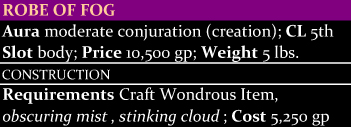
These robes tend to be a dark grey or midnight blue in color, and are always slightly cool to the touch. The wearer is constantly surrounded by misty vapors as though affected by the spell obscuring mist. By default, these mists extend in a 20-ft.-radius area from the wearer, but by concentrating as a move action he can adjust the radius by 10 ft., though he cannot exceed the maximum of a 20-ft. radius. If he reduces the radius to 0 ft. in this way, the mists dissipate, though he can increase the radius to 10 ft. once again as a move action. While the mist can still be blown away by strong wind or burned, as obscuring mist, they automatically reform in 1d4 rounds.
Additionally, once per day, the wearer can cause the fog to instead function as a stinking cloud spell. The fog remains centered on him, but is otherwise identical to the spell, and remains that way for 1 minute before returning to its normal function. The wearer is immune to the nauseating effect of his own stinking cloud.
Teleportation Badge
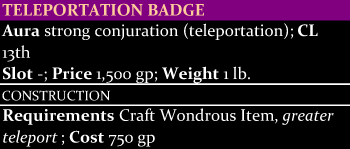
These small badges are typically made of silver, and carved in the shape of a pair of wings, or the silhouette of a running man, or some other indicator of fast travel. There is always a spherical gem set in the middle of the badge, which can be detached. In order to use it, the badge must be placed on a person or object (in the case of the former, the badge may be stuck on the person’s clothing or armor, and will transport the person as well as what they are wearing and/or carrying, up to their maximum load). With a command word (and, in the case of unwilling targets, a touch attack), the badge can be magically affixed to any surface. Another command word (or a DC 15 Strength check) can detach it again.
Meanwhile, the spherical gem can be detached with ease, and the badge’s user typically does so before or while affixing it. At any point, the gem can be shattered, causing the badge (as well as the person or object it was affixed to, up to a maximum weight of 1,300 lbs and a maximum volume of 13 cubic feet) to be transported to the now-broken sphere’s location as though by the spell greater teleport. Unwilling targets may resist this effect with a Will save (DC 20). Whether the target is transported or not, after the attempt is made the badge itself becomes inert and falls off of whatever it was attached to.


